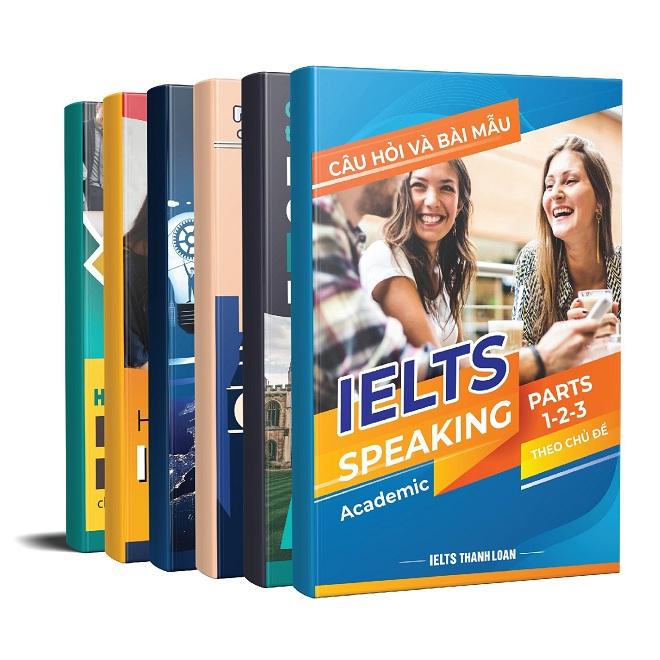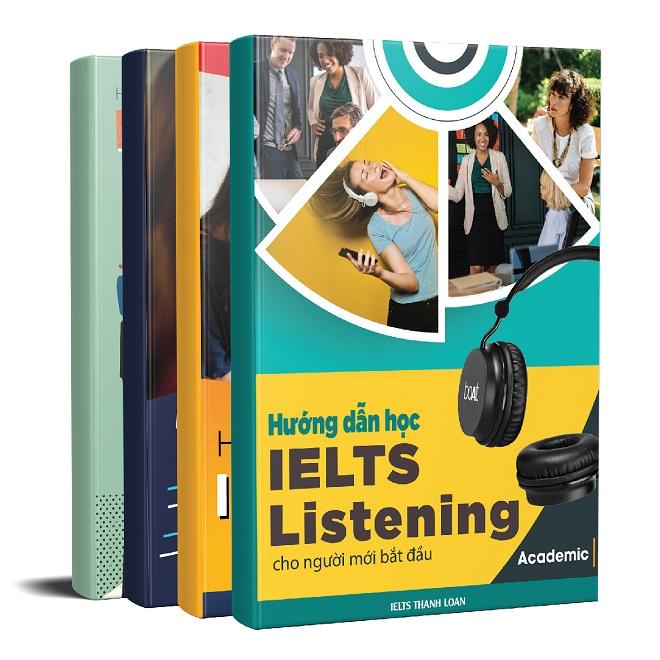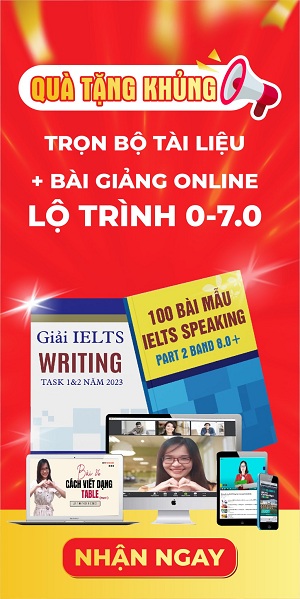Bạn muốn cải thiện kỹ năng IELTS Listening của mình? Phần dịch đề và phân tích đáp án IELTS Listening Cambridge 13 Test 4 dưới đây sẽ giúp bạn hiểu rõ hơn về cách làm bài cũng như rèn luyện kỹ năng Listening một cách tốt nhất. Để đạt được kết quả cao nhất, đừng quên tham gia khóa học luyện thi Tiếng Anh IELTS trực tuyến chất lượng tại IELTS Thanh Loan nhé!
Section 1: Alex’s training
1. Phân tích câu hỏi
Questions 1-10:
Complete the notes below. Write ONE WORD AND/ OR A NUMBER.
|
Alex’s Training(Buổi đào tạo của Alex) Example Alex completed his training in 2014 About the applicant:
Về người nộp đơn:
Benefits of doing training at JPNW:
Lợi ích của việc đào tạo tại JPNW:
Advice for interview:
Lời khuyên khi phỏng vấn:
|
2. Giải thích đáp án
Martha: Hi Alex. It’s Martha Clines here. James White, gave me your number. I hope you don’t mind me calling you.
Chào Alex, tớ là Martha Clines. James White đã cho tớ số điện thoại của cậu. Hi vọng là tớ không làm phiền cậu khi gọi cho cậu thế này.
Alex: Of course not. How are you, Martha?
Không sao đâu. Cậu khỏe chứ Martha?
Martha: Good thanks. I’m ringing because I need a bit of advice.
Cảm ơn cậu, tớ vẫn khỏe. Thật ra tớ gọi cho bạn vì tớ đang cần lời khuyên của cậu.
Alex: Oh, yeah. What about?
Ồ, về việc gì thế?
Martha: The training you did at JPNW a few years ago. I’m applying for the same thing.
À, về kỳ thực tập ở JPNM mà cậu đã tham gia một vài năm trước đấy. Tớ cũng đang ứng tuyển vào vị trí đó.
Alex: Oh,right Yes. I did mine in 2014 (Example). Best thing I ever did. I’m still working there.
Ồ, tớ từng tham gia vào năm 2014. Đấy là một trong những điều tuyệt vời nhất mà tớ trải qua. Hiện tại tớ vẫn đang làm việc ở đấy.
Martha: Really? What are you doing?
Ôi thật sao? Cậu làm gì ở đó vậy?
Alex: Well, now I work in the customer services department but I did my initial training in Finance(Q1). I stayed there for the first two years and then moved to where I am now.
Hiện tại thì tớ đang làm việc tại phòng dịch vụ khách hàng, nhưng thật ra khi vào công ty, thì tớ bắt đầu làm việc tại bộ phận Tài chính. Tớ làm ở đấy trong 2 năm đầu và sau đó chuyển đến bộ phận mà tớ đang làm việc hiện nay.
Martha: That’s the same department I’m applying for. Did you enjoy it?
Ồ, đấy là bộ phận mà tớ đang định ứng tuyển vào. Cậu có thích làm việc ở đấy không vậy?
Alex: I was pretty nervous to begin with. I didn’t do well in my exams at school and I was really worried because I failed Maths (Q2). But it didn’t actually matter because I did lots of courses on the job.
Thật ra thời gian đầu tớ khá căng thẳng. Lúc còn đi học, tớ thường làm không được tốt lắm trong các kỳ kiểm tra, và bởi vì tớ đã từng bị trượt môn toán nên tớ thực sự lo lắng. Tuy nhiên trên thực tế việc đấy không ảnh hưởng gì cả vì tớ đã được học rất nhiều trong quá trình làm việc.
Martha: Did you get a diploma at the end of your trainee period? I’m hoping to do the one in business skills (Q3).
Thế cậu có nhận được chứng chỉ sau khi hoàn thành kỳ thực tập của mình không? Tớ hi vọng sẽ nhận được một chứng chỉ cho kỹ năng kinh doanh.
Alex: Yes. That sounds good I took the one on IT skills but I wish I’d done that one instead.
Ồ, nghe có vẻ tốt đấy. Tớ thì nhận được chứng chỉ về IT, nhưng tớ ước mình có thể nhận được chứng chỉ về kỹ năng kinh doanh.
Martha: OK, that’s good to know. What about the other trainees? How did you get on with them?
Ừm, đó là một tin tốt. Còn các thực tập sinh khác thì sao? Làm thế nào để có thể hòa đồng với họ?
Alex: There were about 20 of us who started at the same time and we were all around the same age – I was 18 and there was only one person younger than me who was 17(Q4). The rest were between 18 and 20. I made some good friends.
Có khoảng 20 thực tập sinh với độ tuổi bằng nhau, tớ 18 tuổi và chỉ có một bạn nhỏ tuổi hơn tớ – 17 tuổi. Những người còn lại tầm 18 -20 tuổi. Tớ và một vài bạn khác đã trở thành bạn tốt của nhau đấy.
Martha: I’ve heard lots of good things about the training at JPNW. It seems like there are a lot of opportunities there.
Tớ đã được nghe nhiều đánh giá tốt về khóa thực tập tại JPNW. Có vẻ như có rất nhiều cơ hội ở đó.
Alex: Yeah, definitely. Because of its size you can work in loads of different areas within the organisation.
Đúng rồi. Bởi vì quy mô của công ty, cậu có thể làm việc với nhiều các lĩnh vực khác nhau trong tổ chức.
Martha: What about pay? I know you get a lower minimum wage than regular employees.
Thế còn về đãi ngộ thì sao? Tớ biết là cậu chỉ được nhận một khoản lương khá thấp so với các nhân viên khác.
Alex: That’s right – which isn’t great. But you get the same number of days holiday as everyone else (Q5). And the pay goes up massively if they offer you a job at the end of the training period.
Đúng rồi. Nhưng cậu vẫn được hưởng số ngày nghỉ phép như các nhân viên khác. Và lương của cậu sẽ được tăng một khoản khá cao nếu sau kỳ thực tập mà cậu nhận được lời mời ở lại làm việc tại công ty.
Martha: Yeah, but I’m not doing it for the money – it’s the experience I think will be really useful. Everyone says by the end of the year you gain so much confidence.
Thực tế tớ ứng tuyển vào chương trình này vì kinh nghiệm mà tớ nghĩ rằng khá hữu ích, chứ không phải vì tiền. Mọi người đều nói rằng, sau một năm làm việc mình sẽ tự tin hơn rất nhiều.
Alex: You’re right. That’s the most useful part about it. There’s a lot of variety too. You’re given lots of different things to do. I enjoyed it all – I didn’t even mind the studying.
Đúng rồi. Đấy chính là phần hữu ích nhất của chương trình thực tập này. Ngoài ra còn nhiều điều thú vị khác nữa. Cậu sẽ được giao nhiều công việc khác nhau. Tớ đã rất thích thú với tất cả công việc mà tớ được giao.
Martha: Do you have to spend any time in college(Q6)?
Cậu có dành thời gian cho việc học ở trường đại học không?
Alex: Yes, one day each month (Q6). So you get lots of support from both your tutor and your manager.
Có chứ, mỗi tháng một ngày. Như vậy cậu sẽ nhận được rất nhiều sự hỗ trợ từ cả trợ giảng lẫn quản lý của cậu.
Martha: That’s good. And the company is easy to get to, isn’t it?
Thế thì tốt quá. Và di chuyển từ công ty đến trường học cũng khá tiện đúng không?
Alex: Yes, it’s very close to the train station so the location’s a real advantage (Q7).
Đúng rồi, nó rất gần trạm tàu điện ngầm, vì vậy vị trí của công ty thực sự rất tiện.
Alex: Have you got a date for your interview yet?
Hôm nào thì cậu phỏng vấn vậy?
Martha: Yes. it’s on the 23rd of this month.
Tớ sẽ phỏng vấn vào ngày 23 tháng này.
Alex: So long as you’re well prepared there’s nothing to worry about. Everyone’s very friendly.
Không cần lo lắng đâu, vì cậu sẽ có đủ thời gian để chuẩn bị tốt mà. Mọi người đều rất thân thiện.
Martha: I am not sure what I should wear. What do you think?
Tớ đang phân vân về việc sẽ mặc gì hôm đấy. Cậu có thể cho tớ lời khuyên được không?
Alex: Nothing too casual – like jeans(Q8), for example- If you’ve got a nice jacket, wear that with a skirt or trousers.
Đừng mặc quần áo ngày thường ví dụ như quần bò – Nếu cậu có áo vest thì thử mặc nó với chân váy hoặc quần âu nhé.
MARTHA: OK Thanks. Any other tips?
Ok, cảm ơn cậu. Cậu còn lời khuyên nào nữa không?
Alex: Erm, well I know it’s really obvious but arrive in plenty of time (Q9). They hate people who are late. So make sure you know exactly where you have to get to. And one other useful piece of advice my manager told me before I had the interview for this job – is to smile (Q10). Even if you feel terrified. It makes people respond better to you.
Umm, tớ biết điều này khá rõ ràng nhưng nhớ đến sớm nhé. Họ không thích những người đến muộn đâu. Do vậy hãy chắc chắn rằng cậu biết chính xác nơi cần đến là đâu. Và một lời khuyên khá hữu ích mà quản lý đã nói với tớ trước khi mình tiến hành phỏng vấn cho vị trí này, đó là hãy mỉm cười. Thậm chí là khí cậu cảm thấy sợ hãi. Việc này giúp mọi người có thiện cảm hơn với cậu đấy.
Martha: I’ll have to practise doing that in the mirror!
Tớ sẽ tập luyện việc này trước gương
ALEX: Yeah – well, good luck. Let me know if you need any more information.
Yeah, chúc cậu may mắn nhé. Nếu cần thêm thông tin gì thì cứ bảo tớ nhé.
Martha: Thanks very much.
Cảm ơn cậu nhiều.
3. Từ vựng
- apply for something (verb):
Nghĩa: to make a formal request, usually in writing, for something such as a job, a loan, permission for something, a place at a university, etc.
Ví dụ: I have decided to apply for this new job. - diploma (noun):
Nghĩa: a document showing that you have completed a course of study or part of your education
Ví dụ: The university awards diplomas in higher education. - get on with somebody (phrasal verb):
Nghĩa: to have a friendly relationship with somebody
Ví dụ: She’s never really got on with her sister. - support (uncountable noun):
Nghĩa: approval that you give to somebody/something because you want them to be successful.
Ví dụ: There is strong public support for the policy. - casual (noun):
Nghĩa: informal clothes or shoes.
Ví dụ: She changed into flat casuals before walking round the town.
Bạn đang chuẩn bị cho kì thi IELTS?
Hãy tham khảo Khóa Học IELTS Online qua ZOOM cùng cô Thanh Loan
IELTS Thanh Loan – giáo viên 10 năm kinh nghiệm – trực tiếp đứng lớp, tự tin mang đến khóa học chất lượng nhất, phương pháp giảng dạy cô đọng dễ hiểu, giáo trình tự biên soạn cho lộ trình từ cơ bản đến luyện đề chuyên sâu. Đặc biệt, học viên luôn được quan tâm sát sao nhất, hỗ trợ không giới hạn, thúc đẩy kỷ luật học tập tốt để đạt mục tiêu.

[stu alias=”khoa_truy_cap_cac_bai_giai_de”]
Section 2: The snow centre
1. Phân tích câu hỏi
Questions 11 – 16
Choose the correct letter, A, B or C.
The Snow Centre
11. Annie recommends that when cross-country skiing, the visitors should
- A. get away from the regular trails.
- B. stop to enjoy views of the scenery.
- C. go at a slow speed at the beginning.
⇒ Annie khuyến cáo rằng khi trượt tuyết băng qua đồng, du khách nên
- A. tránh xa những lối mòn thông thường.
- B. dừng lại để thưởng ngoạn quang cảnh.
- C. lúc đầu đi với vận tốc chậm dần đều.
Chú ý đến cụm từ “cross-country skiing”
12. What does Annie tell the group about this afternoon’s dog-sled trip?
- A. Those who want to can take part in a race.
- B. Anyone has the chance to drive a team of dogs.
- C. One group member will be chosen to lead the trail.
⇒ Annie nói gì với cả nhóm về chuyến đi bằng xe chó kéo vào chiều nay?
- A. Những người muốn có thể tham gia một cuộc đua.
- B. Bất kỳ ai cũng có cơ hội lái một đội chó.
- C. Một thành viên trong nhóm sẽ được chọn để dẫn đường.
Chú ý đến cụm từ “afternoon’s dog-sled trip”
13. What does Annie say about the team relay event?
- A. All participants receive a medal.
- B. The course is 4 km long.
- C. Each team is led by a teacher.
⇒ Annie nói gì về sự kiện tiếp sức đồng đội?
- A. Tất cả những người tham gia đều nhận được huy chương.
- B. Quãng đường dài 4 km.
- C. Mỗi đội do một giáo viên phụ trách.
Chú ý đến cụm từ “team relay event”
14. On the snow-shoe trip, the visitors will
- A. visit an old gold mine.
- B. learn about unusual flowers.
- C. climb to the top of a mountain.
⇒ Trong chuyến đi giày tuyết, du khách sẽ
- A. thăm một mỏ vàng cũ.
- B. tìm hiểu về các loài hoa khác thường.
- C. leo lên đỉnh núi.
Chú ý đến cụm từ “snow-shoe trip”
15. The cost of accommodation in the mountain hut includes
- A. a supply of drinking water.
- B. transport of visitors’ luggage.
- C. cooked meals.
⇒ Chi phí ăn ở trong chòi trên núi bao gồm
- A. nguồn cung cấp nước uống.
- B. vận chuyển hành lý của du khách.
- C. bữa ăn đã nấu chín.
Chú ý đến cụm từ “cost of accommodation”
16. If there is a storm while the visitors are in the hut, they should
- A. contact the bus driver.
- B. wait until the weather improves.
- C. use the emergency locator beacon.
⇒ Nếu có bão trong khi du khách đang ở trong chòi, họ nên
- A. liên hệ với tài xế xe buýt.
- B. đợi cho đến khi thời tiết cải thiện.
- C. sử dụng đèn hiệu định vị khẩn cấp.
Chú ý đến cụm từ “a storm while in the hut”
Questions 17 – 20
What information does Annie give about skiing on each of the following mountain trails?
Choose FOUR answers from the box and write the correct letter, A-F, next to Questions 17-20
|
Mountain trails
|
Information
|
| Annie cung cấp thông tin gì về việc trượt tuyết trên mỗi con đường mòn trên núi sau đây? Chọn BỐN câu trả lời từ các tùy chọn bên dưới và viết đúng chữ cái A-F bên cạnh câu hỏi 17-20. |
|
|
Thông tin
|
Đường mòn trên núi
⇒ Lưu ý có 2 lựa chọn sẽ không là đáp án cho câu hỏi nào. |
2. Giải thích đáp án
|
Hi everyone, welcome to the Snow Centre. My name’s Annie. I hope you enjoyed the bus trip from the airport – we’ve certainly got plenty of snow today! Well, you’ve come to New Zealand’s premier snow and ski centre, and we’ve a whole load of activities for you during your week here. Most visitors come here for the cross-country skiing, where you’re on fairly flat ground for most of the time, rather than going down steep mountainsides. There are marked trails, but you can also leave these and go off on your own and that’s an experience not to be missed (Q11). You can go at your own speed – it’s great aerobic exercise if you really push yourself, or if you prefer you can just glide gently along and enjoy the beautiful scenery. This afternoon, you’ll be going on a dog-sled trip. You may have seen our dogs on TV recently racing in the winter sled festival. If you want, you can have your own team for the afternoon and learn how to drive them (Q12), following behind our leader on the trail. Or if you’d prefer, you can just sit back in the sled and enjoy the ride as a passenger. At the weekend, we have the team relay event, and you’re all welcome to join in. We have a local school coming along, and a lot of the teachers are taking part too. Participation rather than winning is the main focus, and there’s a medal for everyone who takes part (Q13). Participants are in teams of two to four, and each team must complete four laps of the course. For your final expedition, you’ll head off to Mount Frenner wearing a pair of special snow shoes which allow you to walk on top of the snow. This is an area where miners once searched for gold, though there are very few traces of their work left now. When the snow melts in summer, the mountain slopes are carpeted in flowers and plants. It’s a long ascent. though not too steep, and walkers generally take a couple of days to get to the summit (Q14) and return. You’ll spend the night in our hut half-way up the mountain. That’s included in your package for the stay. It’s got cooking facilities, firewood and water for drinking (Q15). For washing, we recommend you use melted snow, though, to conserve supplies. We can take your luggage up on our snowmobile for you for just ten dollars a person. The hut has cooking facilities so you can make a hot meal in the evening and morning, but you need to take your own food. The weather on Mount Frenner can be very stormy. In that case, stay in the hut – generally. the storms don’t last long (Q16). Don’t stress about getting back here to the centre in time to catch the airport bus – they’ll probably not be running anyway. We do have an emergency locator beacon in the hut but only use that if it’s a real emergency, like if someone’s ill or injured. Now, let me tell you something about the different ski trails you can follow during your stay here. Highland Trail’s directly accessible from where we are now. This trail’s been designed to give first-timers an experience they’ll enjoy regardless of their age or skill, but it’s also ideal for experts to practise their technique (Q17). Then there’s Pine Trail … if you’re nervous about skiing, leave this one to the experts! You follow a steep valley looking right down on the river below – scary! But if you’ve fully mastered the techniques needed for hills, it’s great fun (Q18). Stony Trail’s a good choice once you’ve got a general idea of the basics. There are one or two tricky sections, but nothing too challenging. There’s a shelter half-way where you can sit and take a break and enjoy the afternoon sunshine (Q19). And finally, Loser’s Trail. This starts off following a gentle river valley but the last part is quite exposed so the snow conditions can be challenging – if it’s snowing or windy, check with us before you set out to make sure the trail’s open that day (Q20). Right, so now if you’d like to follow me, we’ll get started … |
| Từ vựng trong câu hỏi và đáp án | Từ vựng trong hội thoại | |
| Q11. A | get away from the regular trails | marked trails, but you can also leave these and go off on your own |
| Q12. B | Anyone has the chance to drive a team of dogs | have your own team for the afternoon and learn how to drive them (a team of dogs) |
| Q13. A | All participants receive a medal | there’s a medal for everyone who takes part |
| Q14. C | climb to the top of a mountain | walkers generally take a couple of days to get to the summit |
| Q15. A | a supply of drinking water | got cooking facilities, firewood and water for drinking |
| Q16. B | wait until the weather improves | stay in the hut – generally. the storms don’t last long |
| Q17. B | suitable for
all abilities |
designed to give
first-timers an experience they’ll enjoy regardless of their age or skill, but it’s also ideal for experts to practise their technique |
| Q18. D | demands a lot of skill | fully mastered the techniques needed for hills |
| Q19. A | has a good place
to stop and rest |
a shelter half-way
you can sit and take a break and enjoy the afternoon sunshine |
| Q20. E | may be closed
in bad weather |
check with us before you set out to make sure the trail’s open that day
snow conditions can be challenging – if it’s snowing or windy |
3. Từ vựng
- premier (adj)
Nghĩa: most important, famous or successful
Ví dụ: Last year they won the premier award at the Welsh Festival of Light Opera. - conserve something (verb)
Nghĩa: to protect something and prevent it from being changed or destroyed
Ví dụ: new laws to conserve wildlife in the area - accessible (to somebody) (adj)
Nghĩa: that can be reached, entered, used, seen, etc.
Ví dụ: These documents are not accessible to the public. - tricky (adj) (informal)
Nghĩa: difficult to do or deal with
Ví dụ: Getting it to fit exactly is a tricky business.
Tự học IELTS tại nhà chỉ từ 1.2 triệu?
Tham khảo ngay Khóa học IELTS Online dạng video bài giảng
Giải pháp tự học IELTS tại nhà, tiết kiệm chi phí, linh hoạt thời gian nhưng đảm bảo hiệu quả. Khóa học dạng video bài giảng có lộ trình học từng ngày chi tiết. Học viên học lý thuyết qua video bài giảng, thực hành Listening Reading trực tiếp trên website, còn Writing Speaking được chấm chữa trực tiếp bởi cô Thanh Loan. Mọi bài giảng đều có tài liệu học tập đi kèm.

Section 3: Labels giving nutritional information on food packaging
1. Phân tích câu hỏi
Questions 21-26:
Choose the correct letter A, B or C.
21. What was Jack’s attitude to nutritional food labels before this project?
- A. He didn’t read everything on them.
- B. He didn’t think they were important.
- C. He thought they were too complicated.
⇒ Thái độ của Jack đối với các nhãn thực phẩm dinh dưỡng trước dự án này như thế nào?
- A. Anh ấy không đọc mọi thứ về chúng.
- B. Anh ấy không nghĩ rằng chúng quan trọng.
- C. Anh ấy nghĩ rằng chúng quá phức tạp.
Chú ý đến cụm từ “Jack’s attitude”
22. Alice says that before doing this project.
- A. she was unaware of what certain foods contained.
- B. she was too lazy to read food labels.
- C. she was only interested in the number of calories.
⇒ Alice nói điều đó trước khi thực hiện dự án này.
- A. cô ấy không biết về một số loại thực phẩm có chứa những gì.
- B. cô ấy quá lười để đọc nhãn thực phẩm.
- C. cô ấy chỉ quan tâm đến số lượng calo.
Chú ý đến cụm từ “before this project”
23. When discussing supermarket brands of pizza, Jack agrees with Alice that
- A. the list of ingredients is shocking.
- B. he will hesitate before buying pizza again.
- C. the nutritional label is misleading.
⇒ Khi thảo luận về các nhãn hiệu bánh pizza trong siêu thị, Jack đồng ý với Alice rằng
- A. danh sách các thành phần thực sự gây sốc.
- B. anh ấy sẽ do dự trước khi mua pizza một lần nữa.
- C. nhãn dán dinh dưỡng bị sai lệch.
Chú ý đến cụm từ “Jack agrees with Alice”
24. Jack prefers the daily value system to other labelling systems because it is
- A. more accessible.
- B. more logical.
- C. more comprehensive.
⇒ Jack thích hệ thống giá trị hàng ngày hơn các hệ thống ghi nhãn khác vì nó
- A. dễ tiếp cận hơn.
- B. logic hơn.
- C. toàn diện hơn.
Chú ý đến cụm từ “daily value system”
25. What surprised both students about one flavour of crisps?
- A. The percentage of artificial additives given was incorrect.
- B. The products did not contain any meat.
- C. The labels did not list all the ingredients.
⇒ Điều gì khiến cả hai sinh viên ngạc nhiên về một hương vị khoai tây chiên giòn?
- A. Phần trăm các chất phụ gia nhân tạo đã cho là không chính xác.
- B. Sản phẩm không chứa thịt.
- C. Các nhãn không liệt kê tất cả các thành phần.
Chú ý đến cụm từ “surprised both students”
26. What do the students think about research into the impact of nutritional food labelling?
- A. It did not produce clear results.
- B. It focused on the wrong people.
- C. It made unrealistic recommendations
⇒ Các sinh viên nghĩ gì về nghiên cứu về tác động của việc dán nhãn thực phẩm dinh dưỡng?
- A. Nó không tạo ra kết quả rõ ràng.
- B. Nó tập trung vào sai đối tượng.
- C. Nó đưa ra các khuyến nghị không thực tế
Chú ý đến cụm từ “impact of nutritional food labelling”
Questions 27 and 28: Choose TWO letters A-E.
Which TWO things surprised the students about the traffic-light system for nutritional labels?
- A. its widespread use
- B. the fact that it is voluntary for supermarkets
- C. how little research was done before its introduction
- D. its unpopularity with food manufacturers
- E. the way that certain colours are used
HAI điều nào khiến học sinh ngạc nhiên về hệ thống đèn giao thông dán nhãn dinh dưỡng?
- A. Sử dụng rộng rãi
- B. thực tế là nó là tự nguyện cho các siêu thị
- C. làm thế nào ít nghiên cứu đã được thực hiện trước khi giới thiệu nó
- D. không phổ biến với các nhà sản xuất thực phẩm
- E. là cách mà một số màu được sử dụng
Chú ý đến cụm từ “things surprised students”
Questions 29 and 30: Choose TWO letters, A-E
Which TWO things are true about the participants in the study on the traffic-light system?
- A. They had low literacy levels.
- B. They were regular consumers of packaged food.
- C. They were selected randomly.
- D. They were from all socio-economic groups.
- E. They were interviewed face-to-face.
HAI điều nào đúng về những người tham gia nghiên cứu về hệ thống đèn giao thông?
- A. Họ có trình độ dân trí thấp.
- B. Họ là những người tiêu dùng thường xuyên thực phẩm đóng gói.
- C. Họ được chọn ngẫu nhiên.
- D. Họ đến từ tất cả các nhóm kinh tế xã hội.
- E. Họ đã được phỏng vấn trực tiếp.
Chú ý đến cụm từ “things are true about participants”
2. Giải thích đáp án
JACK: I’ve still got loads to do for our report on nutritional food labels.
Tớ vẫn còn rất nhiều việc phải làm cho báo cáo của chúng ta về nhãn thực phẩm dinh dưỡng.
ALICE: Me too. What did you learn from doing the project about your own shopping habits?
Tớ cũng vậy. Bạn học được gì khi thực hiện dự án về thói quen mua sắm của chính mình?
JACK: Well, I’ve always had to check labels for traces of peanuts in everything I eat because of my allergy. But beyond that I’ve never really been concerned enough to check how healthy a product is (Q21).
Đó là tớ luôn phải kiểm tra nhãn để tìm dấu vết của đậu phộng trong mọi thứ mà tớ ăn vì chứng dị ứng của tớ. Nhưng ngoài ra, tớ chưa bao giờ thực sự quan tâm đến việc kiểm tra mức độ lành mạnh của một sản phẩm.
ALICE: This project has actually taught me to read the labels much more carefully. I tended to believe claims on packaging like ‘low in fat’. But I now realise that the ‘healthy’ yoghurt I’ve bought for years is full of sugar and that it’s actually quite high in calories (Q22).
Dự án này đã thực sự dạy tớ là phải đọc nhãn cẩn thận hơn nhiều. Tớ có xu hướng tin vào những lời trên bao bì như ‘ít chất béo’. Nhưng bây giờ tớ nhận ra rằng sữa chua ‘lành mạnh’ mà tớ đã mua trong nhiều năm chứa đầy đường và nó thực sự chứa khá nhiều calo.
JACK: Ready meals are the worst … comparing the labels on supermarket pizzas was a real eye-opener. Did you have any idea how many calories they contain? I was amazed.
Bữa ăn sẵn là tệ nhất … so sánh nhãn trên pizza siêu thị là một điều thú vị. Bạn có biết chúng chứa bao nhiêu calo không? Tớ đã rất ngạc nhiên đấy.
ALICE: Yes, because unless you read the label really carefully, you wouldn’t know that the nutritional values given are for half a pizza (Q23).
Có, bởi vì trừ khi bạn đọc nhãn thực sự cẩn thận, cậu sẽ không biết rằng các giá trị dinh dưỡng được cung cấp cho một nửa bánh pizza.
JACK: When most people eat the whole pizza. Not exactly transparent iş it?
Khi hầu hết mọi người ăn cả chiếc bánh pizza. Nó không đưa ra thông tin chính xác minh bạch gì cả?
ALICE: Not at all. But I expect it won’t stop you from buying pizza?
Đúng thế. Nhưng tớ hy vọng nó sẽ không ngăn bạn mua pizza?
JACK: Probably not, no! I thought comparing the different labelling systems used by food manufacturers was interesting. I think the kind of labelling system used makes a big difference.
Có lẽ không, không! Tớ nghĩ rằng việc so sánh các hệ thống ghi nhãn khác nhau được các nhà sản xuất thực phẩm sử dụng thật thú vị. Tớ nghĩ loại hệ thống ghi nhãn được sử dụng tạo ra sự khác biệt lớn.
ALICE: Which one did you prefer?
Bạn thích cái nào hơn?
JACK: I liked the traditional daily value system best – the one which tells you what proportion of your required daily intake of each ingredient the product contains. I’m not sure it’s the easiest for people to use but at least you get the full story (Q24). I like to know all the ingredients in a product – not just how much fat, salt and sugar they contain.
Tớ thích nhất hệ thống giá trị hàng ngày truyền thống – hệ thống cho bạn biết tỷ lệ tiêu thụ hàng ngày của bạn đối với mỗi thành phần trong sản phẩm. Tớ không chắc nó là cách dễ dàng nhất để mọi người sử dụng nhưng ít nhất bạn có được câu chuyện đầy đủ. Tớ muốn biết tất cả các thành phần trong một sản phẩm – không chỉ là chúng chứa bao nhiêu chất béo, muối và đường.
ALICE: But it’s good supermarkets have been making an effort to provide reliable information for customers.
Nhưng các siêu thị tốt đã và đang nỗ lực để cung cấp thông tin đáng tin cậy cho khách hàng.
JACK: Yes. There just needs to be more consistency between labelling systems used by different supermarkets, in terms of portion sizes, etc.
Đúng. Chỉ cần có sự thống nhất hơn giữa các hệ thống ghi nhãn được sử dụng bởi các siêu thị khác nhau, về kích cỡ khẩu phần, v.v.
ALICE: Mmm. The labels on the different brands of chicken flavour crisps were quite revealing too, weren’t they?
Ừm. Nhãn trên các nhãn hiệu khác nhau của khoai tây chiên hương vị gà cũng khá tiết lộ được, phải không?
JACK: Yeah. I don’t understand how they can get away with calling them chicken flavour when they only contain artificial additives (Q25).
Vâng. Tớ không hiểu bằng cách nào họ có thể gọi chúng là hương vị gà khi chúng chỉ chứa các chất phụ gia nhân tạo.
ALICE: I know. I’d at least have expected them to contain a small percentage of real chicken.
Tớ biết. Ít nhất thì tớ cũng đã mong đợi chúng chứa một tỷ lệ nhỏ gà thật.
JACK: Absolutely
Chắc chắn rồi.
ALICE: I think having nutritional food labeling has been a good idea, don’t you? I think it will change people’s behaviour and stop mothers, in particular, buying the wrong things.
Tớ nghĩ việc dán nhãn thực phẩm dinh dưỡng là một ý kiến hay, phải không? Tớ nghĩ rằng nó sẽ thay đổi hành vi của mọi người và ngăn chặn các bà mẹ, đặc biệt là mua những thứ sai trái.
JACK: But didn’t that study kind of prove the opposite? People didn’t necessarily stop buying unhealthy products.
Nhưng không phải loại nghiên cứu đó đã chứng minh điều ngược lại? Mọi người không nhất thiết phải ngừng mua các sản phẩm không lành mạnh.
ALICE: They only said that might be the case. Those findings weren’t that conclusive (Q26) and it was quite a small-scale study. I think more research has to be done.
Họ chỉ nói rằng đó có thể là trường hợp. Những phát hiện đó không phải là kết luận và nó là một nghiên cứu quy mô nhỏ. Tôi nghĩ rằng nhiều nghiên cứu hơn phải được thực hiện.
JACK: Yes, I think you’re probably right.
Vâng, tớ nghĩ bạn có thể đúng.
JACK: What do you think of the traffic light system?
Bạn nghĩ gì về hệ thống đèn giao thông?
ALICE: I think supermarkets like the idea of having a colour-coded system – red, orange or green – for levels of fat, sugar and salt in a product.
Tớ nghĩ rằng các siêu thị thích ý tưởng có một hệ thống mã màu – đỏ, cam hoặc xanh lá cây – cho các mức chất béo, đường và muối trong một sản phẩm.
JACK: But it’s not been adopted universally (Q27 & 28). And not on all products. Why do you suppose that is?
Nhưng nó không được chấp nhận phổ biến. Và không phải trên tất cả các sản phẩm. Tại sao bạn lại cho rằng như thế?
ALICE: Pressure from the food manufacturers. Hardly surprising that some of them are opposed to flagging up how unhealthy their products are.
Áp lực từ các nhà sản xuất thực phẩm. Hầu như không ngạc nhiên khi một số người trong số họ phản đối việc gắn cờ các sản phẩm của họ không lành mạnh như thế nào.
JACK: I’d have thought it would have been compulsory. It seems ridiculous it isn’t.
Tớ đã nghĩ rằng nó sẽ là bắt buộc. Nó có vẻ vô lý, nó lại không phải.
ALICE: I know. And what I couldn’t get over is the fact that it was brought in without enough consultation – a lot of experts had deep reservations about it.
Tớ biết. Và điều tớ không thể vượt qua là thực tế là nó đã được đưa đến mà không có sự tham vấn đầy đủ – rất nhiều chuyên gia đã e dè sâu sắc về nó.
JACK: That is a bit weird. I suppose there’s an argument for doing the research now when consumers are familiar with this system.
Đó là một chút kỳ lạ. Tớ cho rằng có một lý do để thực hiện nghiên cứu ngay bây giờ khi người tiêu dùng đã quen thuộc với hệ thống này.
ALICE: Yeah, maybe.
Đúng, có lẽ vậy.
JACK: The participants in the survey were quite positive about the traffic light system.
Những người tham gia khảo sát đánh giá khá tích cực về hệ thống đèn giao thông
ALICE: Mmm. But I don’t think they targeted the right people. They should have focused on people with low literacy levels because these labels are designed to be accessible to them.
Ừm. Nhưng tớ không nghĩ rằng họ đã nhắm đúng người. Họ nên tập trung vào những người có trình độ dân trí thấp vì những nhãn này được thiết kế để họ có thể tiếp cận được.
JACK: Yeah. But it’s good to get feedback from all socio-economic groups (Q29 &30). And there wasn’t much variation in their responses.
Ừm. Nhưng thật tốt khi nhận được phản hồi từ tất cả các nhóm kinh tế xã hội. Và không có nhiều sự thay đổi trong các câu trả lời của họ.
ALICE: No. But if they hadn’t interviewed participants face-to-face, they could have used a much bigger sample size. I wonder why they chose that method?
Nhưng nếu họ không phỏng vấn trực tiếp những người tham gia, họ có thể đã sử dụng cỡ mẫu lớn hơn nhiều. Tớ cứ tự hỏi tại sao họ lại chọn phương pháp đó?
JACK: Dunno. How were they selected? Did they volunteer or were they approached?
Không biết. Họ đã được chọn như thế nào? Họ tình nguyện hay họ được tiếp cận?
ALICE: I think they volunteered. The thing that wasn’t stated was how often they bought packaged food – all we know is how frequently they used the supermarket.
Tôi nghĩ họ đã tình nguyện. Điều không được nêu là tần suất họ mua thực phẩm đóng gói – tất cả những gì chúng ta biết là tần suất họ sử dụng siêu thị.
| Từ vựng trong câu hỏi và đáp án | Từ vựng trong hội thoại | |
| Q21. A | didn’t read everything on them | never really been concerned enough to check how healthy a product is |
| Q22. A | unaware of what certain foods contained | believe claims on packaging like ‘low in fat’
now realise that the ‘healthy’ yoghurt I’ve bought for years is full of sugar and that it’s actually quite high in calories |
| Q23. C | nutritional label is misleading | Not exactly transparent |
| Q24. C | more comprehensive | at least you get the full story |
| Q25. B | products did not contain any meat | how they get away with calling them chicken flavour when only contain artificial additives |
| Q26. A | not produce clear results | findings weren’t that conclusive |
| Q27. B | voluntary for supermarkets | not been adopted universally |
| Q28. C | how little research was done before its introduction | it was brought in without enough consultation |
| Q29. D | were from all socio-economic groups | get feedback from all socio-economic groups |
| Q30. E | were interviewed face-to-face | interviewed participants face-to-face |
3. Từ vựng
- nutritional (adj):
Nghĩa: connected with the process by which living things receive the food necessary for them to grow and be healthy
Ví dụ: the nutritional value of milk - allergy (noun):
Nghĩa: a medical condition that causes you to react badly or feel ill when you eat or touch a particular substance
Ví dụ: He suffers from a severe nut allergy. - eye-opener (noun):
Nghĩa: an event, experience, etc. that is surprising and shows you something that you did not already know
Ví dụ: Travelling around India was a real eye-opener for me. - intake (noun):
Nghĩa: the amount of food, drink, etc. that you take into your body
Ví dụ: to reduce your daily intake of salt - make an effort to do something (verb):
Nghĩa: attempt to do something
Ví dụ: Please make an effort to be on time. - consistency (uncountable noun):
Nghĩa: the quality of always behaving in the same way or of having the same opinions, standard, etc.; the quality of being consistent
Ví dụ: She has played with great consistency all season. - additive (noun):
Nghĩa: a substance that is added in small amounts to something, especially food, in order to improve it, give it colour, make it last longer, etc.
Ví dụ: food additives - ridiculous (adj):
Nghĩa: very silly or unreasonable
Ví dụ: I look ridiculous in this hat. - consultation (uncountable noun):
Nghĩa: the act of discussing something with somebody or with a group of people before making a decision about it
Ví dụ: The decision was taken after close consultation with local residents. - face to face (adj):
Nghĩa: involving people who are close together and looking at each other
Ví dụ: a face-to-face conversation
Tài liệu IELTS nào phù hợp với band 6.0+
Combo 6 cuốn sách luyện đề IELTS sát thật, tỉ lệ trúng tủ cao
- Dịch song ngữ, giải chi tiết IELTS Listening & Reading Cam 7-19
- Hơn 100 bài mẫu IELTS Writing Task 1 & 2 band 7.0+ đa dạng chủ đề
- Bài mẫu Speaking Part 1-2-3 cho 56 chủ đề thường gặp
Đảm bảo đây là bộ sách luyện đề IELTS sát thật, dễ đọc, và chi tiết nhất dành riêng cho sĩ tử IELTS Việt Nam.

Section 4: The history of coffee
Questions 31 – 40
Complete the notes below. Write ONE WORD ONLY for each answer.
The history of coffee
Lịch sử của cà phê
Coffee in the Arab world
- There was small-scale trade in wild coffee from Ethiopia.
- 1522: Coffee was approved in the Ottoman court as a type of medicine.
- 1623: In Constantinople, the ruler ordered the (31) ………. of every coffee house.
|
Cà phê ở thế giới Ả Rập
⇒ Chỗ trống cần điền 1 noun bổ sung nghĩa cho cụm “every coffee house” |
Coffee arrives in Europe (17th century)
- Coffee shops were compared to (32) ……….
- They played an important part in social and (33) ………. changes.
|
Cà phê đến Châu Âu (thế kỷ 17)
|
Coffee and European colonisation
- European powers established coffee plantations in their colonies
- Types of coffee were often named according to the (34) ………. they came from.
- In Brazil and the Caribbean, most cultivation depended on (35) ……….
- In Java, coffee was used as a form of (36) ……….
- Coffee became almost as important as (37) ……….
- The move towards the consumption of (38) ………. in Britain did not also take place in the USA.
|
Cà phê và thuộc địa hóa châu Âu
|
Coffee in the 19th century
- Prices dropped because of improvements in (39) ……….
- Industrial workers found coffee helped them to work at (40) ……….
|
Cà phê thế kỷ 19
|
In my presentation, I’m going to talk about coffee, and its importance both in economic and social terms. We think it was first drunk in the Arab world, but there’s hardly any documentary evidence of it before the 1500s, although of course that doesn’t mean that people didn’t know about it before then.
Trong bài thuyết trình của mình, tôi sẽ nói về cà phê, và tầm quan trọng của nó cả về mặt kinh tế và xã hội. Chúng ta thường nghĩ rằng nó được uống lần đầu tiên ở thế giới Ả Rập, nhưng hầu như không có bất kỳ bằng chứng tài liệu nào về nó trước những năm 1500, mặc dù tất nhiên điều đó không có nghĩa là mọi người không biết về nó trước đó.
However, there is evidence that coffee was originally gathered from bushes growing wild in Ethiopia, in the northeast of Africa. In the early sixteenth century, it was being bought by traders, and gradually its use as a drink spread throughout the Middle East. It’s also known that in 1522, in the Turkish city of Constantinople, which was the centre of the Ottoman Empire, the court physician approved its use as a medicine.
Tuy nhiên, có bằng chứng cho thấy cà phê ban đầu được hái từ các bụi cây mọc hoang ở Ethiopia, phía đông bắc châu Phi. Vào đầu thế kỷ thứ mười sáu, nó đã được các thương nhân mua lại, và dần dần việc sử dụng nó như một thức uống lan rộng khắp Trung Đông. Người ta cũng biết rằng vào năm 1522, tại thành phố Constantinople của Thổ Nhĩ Kỳ, là trung tâm của Đế chế Ottoman, thái y đã chấp thuận việc sử dụng nó như một loại thuốc.
By the mid-1500s, coffee bushes were being cultivated in Yemen and for the next hundred years this region produced most of the coffee drunk in Africa and the Arab world. What’s particularly interesting about coffee is its effect on social life. It was rarely drunk at home, but instead people went to coffee houses to drink it. These people, usually men, would meet to drink coffee and chat about issues of the day. But at the time, this chance to share ideas and opinions was seen as something that was potentially dangerous, and in 1623 the ruler of Constantinople demanded the destruction of all the coffee houses in the city (Q31), although after his death many new ones opened, and coffee consumption continued. In the seventeenth century, coffee drinking spread to Europe, and here too coffee shops became places where ordinary people, nearly always men, could meet to exchange ideas. Because of this, some people said that these places performed a similar function to universities (Q32). The opportunity they provided for people to meet together outside their own homes and to discuss the topics of the day had an enormous impact on social life, and many social movements and political developments had their origins in coffee house discussions (Q33).
Vào giữa những năm 1500, những bụi cà phê đã được trồng ở Yemen và trong hàng trăm năm tiếp theo, khu vực này sản xuất hầu hết lượng cà phê được uống ở châu Phi và thế giới Ả Rập. Điều đặc biệt thú vị của cà phê là tác dụng của nó đối với đời sống xã hội. Nó hiếm khi được uống ở nhà, mà thay vào đó mọi người đến các quán cà phê để uống nó. Những người này, thường là nam giới, sẽ gặp nhau để uống cà phê và trò chuyện về các vấn đề trong ngày. Nhưng vào thời điểm đó, cơ hội chia sẻ ý kiến và quan điểm này được coi là một điều gì đó tiềm ẩn nguy hiểm, và vào năm 1623, người cai trị Constantinople yêu cầu phá hủy tất cả các quán cà phê trong thành phố, mặc dù sau khi ông qua đời, nhiều quán cà phê mới được mở ra, và tiếp tục tiêu thụ cà phê. Vào thế kỷ XVII, việc uống cà phê lan sang châu Âu, và tại đây các quán cà phê cũng trở thành nơi mà những người bình thường, gần như luôn luôn là nam giới, có thể gặp gỡ để trao đổi ý kiến. Chính vì vậy, một số ý kiến cho rằng những nơi này thực hiện chức năng tương tự như trường đại học. Cơ hội mà họ tạo ra để mọi người gặp nhau bên ngoài nhà riêng của họ và thảo luận về các chủ đề trong ngày đã có tác động to lớn đến đời sống xã hội, và nhiều phong trào xã hội và sự phát triển chính trị bắt nguồn từ các cuộc thảo luận tại quán cà phê.
In the late 1600s, the Yemeni monopoly on coffee production broke down and coffee production started to spread around the world, helped by European colonisation. Europeans set up coffee plantations in Indonesia and the Caribbean and production of coffee in the colonies skyrocketed. Different types of coffee were produced in different areas, and it’s interesting that the names given to these different types, like Mocha or Java coffee, were often taken from the port they were shipped to Europe from (Q34). But if you look at the labour system in the different colonies, there were some significant differences.
Vào cuối những năm 1600, sự độc quyền về sản xuất cà phê của Yemen đã bị phá vỡ và việc sản xuất cà phê bắt đầu lan rộng khắp thế giới, nhờ sự giúp đỡ của thực dân châu Âu. Người châu Âu đã thiết lập các đồn điền cà phê ở Indonesia và Caribe và sản lượng cà phê ở các thuộc địa đã tăng vọt. Các loại cà phê khác nhau được sản xuất ở các khu vực khác nhau, và điều thú vị là những cái tên được đặt cho những loại khác nhau này, như cà phê Mocha hoặc Java, thường được lấy từ cảng mà chúng được vận chuyển đến châu Âu. Nhưng nếu bạn nhìn vào hệ thống lao động ở các thuộc địa khác nhau, có một số khác biệt đáng kể.
In Brazil and the various Caribbean colonies, coffee was grown in huge plantations and the workers there were almost all slaves (Q35). But this wasn’t the same in all colonies; for example in Java, which had been colonised by the Dutch, the peasants grew coffee and passed a proportion of this on to the Dutch, so it was used as a means of taxation (Q36). But whatever system was used, under the European powers of the eighteenth century, coffee production was very closely linked to colonisation. Coffee was grown in ever-increasing quantities to satisfy the growing demand from Europe, and it became nearly as important as sugar production (Q37), which was grown under very similar conditions. However, coffee prices were not yet low enough for people to drink it regularly at home, so most coffee consumption still took place in public coffee houses and it still remained something of a luxury item. in Britain, however, a new drink was introduced from China, and started to become popular, gradually taking over from coffee, although at first it was so expensive that only the upper classes could afford it. This was tea, and by the late 1700s it was being widely drunk. However, when the USA gained independence from Britain in 1776, they identified this drink with Britain, and coffee remained the preferred drink in the USA (Q38), as it still is today.
Ở Brazil và các thuộc địa Caribe khác nhau, cà phê được trồng trong các đồn điền lớn và công nhân ở đó hầu như là nô lệ. Nhưng điều này không giống nhau ở tất cả các thuộc địa; ví dụ như ở Java, nơi đã bị người Hà Lan đô hộ, nông dân trồng cà phê và chuyển một phần cà phê này cho người Hà Lan, vì vậy nó được sử dụng như một phương tiện đánh thuế. Nhưng bất kể hệ thống nào được sử dụng, dưới thời các cường quốc châu Âu vào thế kỷ thứ mười tám, việc sản xuất cà phê có mối liên hệ chặt chẽ với quá trình thuộc địa hóa. Cà phê được trồng với số lượng ngày càng tăng để đáp ứng nhu cầu ngày càng tăng từ châu Âu, và nó trở nên quan trọng như đường. sản xuất, được trồng trong những điều kiện rất giống nhau. Tuy nhiên, giá cà phê vẫn chưa đủ thấp để mọi người có thể uống thường xuyên tại nhà, vì vậy hầu hết việc tiêu thụ cà phê vẫn diễn ra ở các quán cà phê công cộng và nó vẫn là một thứ xa xỉ phẩm. Tuy nhiên, ở Anh, một loại đồ uống mới được du nhập từ Trung Quốc, và bắt đầu trở nên phổ biến, dần dần chiếm ưu thế từ cà phê, mặc dù ban đầu nó đắt đến mức chỉ có giới thượng lưu mới có thể mua được. Đó là trà, và vào cuối những năm 1700, nó đã được uống rộng rãi. Tuy nhiên, khi Hoa Kỳ giành được độc lập từ Anh vào năm 1776, họ đã đồng nhất thức uống này với Anh, và cà phê vẫn là thức uống được ưa thích ở Hoa Kỳ, như ngày nay.
So, by the early nineteenth century, coffee was already being widely produced and consumed. But during this century, production boomed and coffee prices started to fall. This was partly because new types of transportation had been developed which were cheaper and more efficient (Q39). So now, working people could afford to buy coffee – it wasn’t just a drink for the middle classes. And this was at a time when large parts of Europe were starting to work in industries. And sometimes this meant their work didn’t stop when it got dark; they might have to continue throughout the night (Q40). So, the use of coffee as a stimulant became important – it wasn’t just a drink people drank in the morning, for breakfast.
Vì vậy, vào đầu thế kỷ XIX, cà phê đã được sản xuất và tiêu thụ rộng rãi. Nhưng trong thế kỷ này, sản xuất bùng nổ và giá cà phê bắt đầu giảm. Điều này một phần là do các loại hình vận tải mới đã được phát triển, rẻ hơn và hiệu quả hơn. Vì vậy, giờ đây, những người đi làm đã có thể mua cà phê – nó không chỉ là thức uống dành cho tầng lớp trung lưu. Và đây là thời điểm mà phần lớn châu Âu đang bắt đầu làm việc trong các ngành công nghiệp. Và đôi khi điều này có nghĩa là công việc của họ không dừng lại khi trời tối; họ có thể có để tiếp tục suốt đêm. Vì vậy, việc sử dụng cà phê như một chất kích thích trở nên quan trọng – nó không chỉ là thức uống mà mọi người uống vào buổi sáng, mà nó là bữa sáng của họ.
There were also changes in cultivation …
Cũng có những thay đổi trong trồng trọt
| Từ vựng trong câu hỏi & đáp án | Từ vựng trong hội thoại | |
| Q31. destruction | ruler ordered destruction of every coffee house | ruler demanded the destruction of all coffee houses |
| Q32. university/
Universities |
coffee shops were compared to universtiy | these places performed a similar function to universities |
| Q33. political | played an important part in social and political changes | many social movements and political developments |
| Q34.
port(s) |
Types of coffee were often named according to port they came from | names given to these different types were often taken from the port they were shipped |
| Q35. slave/ slavery | most cultivation depended on slave | coffee was grown in huge plantations and workers there were almost all slaves |
| Q36. taxation | coffee was used as a form of taxation | used as a means of taxation |
| Q37. sugar | coffee became almost as important as sugar | nearly as important as sugar production |
| Q38. tea | move towards the consumption of tea not take place in the USA | a new drink was introduced from China, and started to become popular. This is tea |
| Q39. transportation | Prices dropped
because of improvements in transportation |
Coffee prices fall
because new types of transportation had been developed |
| Q40. night | Industrial workers found coffee helped them to work at night | continue throughout the night |
3. Từ vựng
- cultivate something (verb):
Nghĩa: to prepare and use land for growing plants or crops
Ví dụ: The land around here has never been cultivated. - ruler (noun):
Nghĩa: a person who rules or governs
Ví dụ: He eventually became ruler over all Egypt. - consumption (uncountable noun):
Nghĩa: the act of using energy, food or materials; the amount used
Ví dụ: Gas and oil consumption always increases in cold weather. - monopoly on something (noun):
Nghĩa: the complete control of trade in particular goods or the supply of a particular service
Ví dụ: In the past central government had a monopoly on television broadcasting. - skyrocket (verb):
Nghĩa: (of prices, etc.) to rise quickly to a very high level
Ví dụ: Wages and prices have skyrocketed. - take over (from something) (phrasal verb):
Nghĩa: to become bigger or more important than something else; to replace something
Ví dụ: Try not to let negative thoughts take over. - afford something (verb):
Nghĩa: to have enough money to be able to buy or do something
Ví dụ: Can we afford a new car? - efficient (adj):
Nghĩa: doing something in a good, careful and complete way with no waste of time, money or energy
Ví dụ: This is simply the most efficient way to do it.
Mới bắt đầu học IELTS, tài liệu nào tốt?
Combo 4 cuốn Hướng dẫn tự học IELTS dành riêng cho người Việt
- Listening & Reading: Tiếp cận IELTS theo từng dạng câu hỏi, chia sẻ chiến thuật làm bài, mẹo hay cho từng dạng, và bài tập thực hành theo dạng.
- Writing: Hướng dẫn chi tiết cách viết câu – đoạn – bài văn và nhiều templates phong phú, rất dễ áp dụng
- Speaking: Cấu trúc câu trả lời tốt cho Speaking Part 1-2-3 kèm từ vựng phổ biến
Chắc chắn đây là bộ sách cực dễ đọc và dễ áp dụng cho sĩ tử IELTS Việt Nam.

[/stu]












